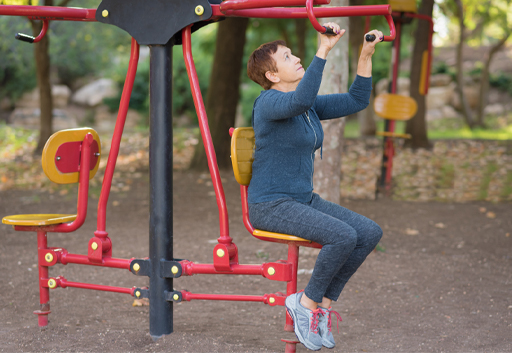5 Physical activity as respite
As outlined in Session 1, caring for someone can be relentless and exhausting so taking a break, or using respite care, is vital for a carer’s wellbeing (Carers UK, 2021). Video 4 uses a helpful analogy to allow carers to see why it is so important to prioritise their own wellbeing and value self-care (see Further Reading for more information on self-care).

Transcript: Video 4 How can we support carers?
As highlighted in the video, and from what you have learnt in this session so far, physical activity can provide self-care opportunities for carers with both physical and mental health benefits. This time away for adult carers can be spent alone, or with company, and be used to enjoy being physically active through activities such as gardening, going for a walk, or using the facilities in a local park, all of which can be enjoyed alongside the benefits of being outdoors (Methley et al., 2020). As well as the physical and mental health benefits, these are all activities that can be completed at no cost. The NHS (2019b) provides guidance to ‘get fit for free’, which you can access via the link given in Further reading.

For young carers, being physically active independently could be more challenging and they might need to be part of organised, supervised activities. Indeed, carers of any age might prefer to be part of a social group, such as a group yoga class, for their active respite, as evidence highlights that carers can often become isolated (Carers UK, 2019; Carers Trust, 2021). You might recall that being active and connecting with others combines two of the Five Ways of Wellbeing mentioned in Section 1.
There are, however, carers who might feel less comfortable leaving their care recipient. In addition, Madruga et al. (2020) argues that there can be access issues for carers, particularly for those in rural areas, and identifies that home-based exercises can be more convenient for the caring population. One outcome of the 2020 COVID-19 pandemic, and the resulting movement restrictions put in place, was a shift to individuals seeking physical activity and exercise opportunities at home and in an online format. This has resulted in an increase in home-based exercise options becoming available and organisations such as Sport England have provided guidance (see Further Reading). It is important to remember, however, that it is the motivation to be active that must also be supported, as you will explore in Activity 7.
Activity 7
Listen to the short audio clip of the BBC 5Live radio interview with Candice Lingam-Willgoss, Senior Lecturer in Sport and Fitness at The Open University, as she talks about exercising during the pandemic and how we might be facilitated to be active. As you listen, consider how what was recommended during the winter lockdown of January 2021 might be applied to carers.
Transcript: Audio 6
[MUSIC PLAYING]
Discussion
Candice offers her top tips to get people active and recommends individuals can be more motivated to exercise if they create an exercise space, have the right kit and listen to music, among other top tips. Taking part in a variety of activities was suggested to avoid boredom and perhaps the key aspect that was emphasised was setting goals (see Further Reading for more information).
You might have reflected that setting physical activity goals can be helpful to carers to support their motivation to be active. Candice’s comment that physical activity ‘always makes you feel better’ might also have interested you. In the previous sections, you considered the barriers that carers face to being physically active, but with the knowledge that in spite of fatigue and tiredness, physical activity will help carers to feel better, it might be the boost that you need.
You will now examine how a carer can be active with their care recipient.
